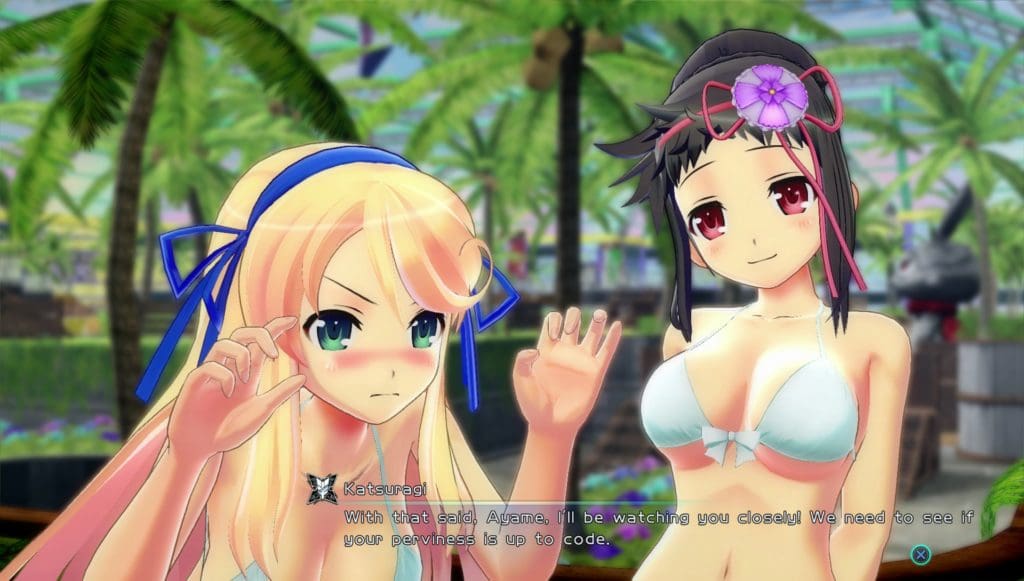Peach Beach Splash, being what looks like the girls’ last lighthearted adventure before the looming events of the next big game in the series, is a good place to stop and look back at the series as a whole. For me, that means looking back at my own experiences in working on the series, and what I’ve learned along the way.

I started at XSEED a few weeks before SENRAN KAGURA Burst launched in North America. Despite being only a T-rated game (no, really, Burst was rated T!), it was easily the raunchiest title we’d ever published, and none of us knew how Western audiences would react. We had an office betting pool over how many copies would sell in its opening week, and I bet on the highest number and won lunch at Yogurtland. (Come to think of it, I don’t think I ever cashed that in. I’ll have to talk to Ken about that later.)
Fans of series creator Takaki-san might know that he didn’t originally plan on Burst having a sequel — in fact, while developing the original story, he considered killing all the characters off. Thankfully, the final draft let the Hanzō and Hebijo girls live to fight another day, and before long, he and his team started work on SENRAN KAGURA Shinovi Versus.

By the time Burst launched, we were already looking forward to publishing Shinovi Versus in North America, especially after seeing the success of the first game. About half the office worked on localizing Shinovi Versus in one capacity or another, with Jason and Junpei on translation, Tom and myself taking care of the editing (Tom on the Crimson Squad storyline, me on most of the rest), and Brittany as our go-to continuity consultant.
Shinovi Versus wasn’t just my first XSEED localization project, but also my first project where every line of dialogue was voiced over in another language. That, among other factors, gradually changed the way I approached localization in general.

When I worked on my very first localization project overall, all the way back in 2005 for a different publisher, the general directive from up above was to be accurate to the story and the characterization (the localization test I took included the line, “Don’t add a reference to a giant ogre if there isn’t one in the original text”), but also to make the text as enjoyable to read in English as possible. Of course, since Japanese and English have markedly different styles and cadences, there often comes a point where accuracy and enjoyability diverge, and an editor has to bite the bullet and prioritize one over the other. At the time, the decisions more often came down on the side of enjoyability, as long as it didn’t outright contradict the original text.
For that project in particular, since there was a huge amount of text in the first several hours of gameplay, we were encouraged to add more humor in the early going (when possible, and when reasonably appropriate within the context of the scene). If a line flat-out didn’t make sense — which does happen sometimes, when a lengthy, sprawling script gets written long before the game gets made — we were more or less free to replace it with a line of our own invention (again, as long as it fit the context).

That sort of approach, where the Japanese text was considered more of a guideline than a baseline, was common at the time, and it stuck with me through many other projects over the next eight years. When writing for a wide audience, who usually just wanted to enjoy the game in English, that worked out fine most of the time. When writing for anyone who knew the Japanese…not so much.
For those who know the language, even a little bit, it’s immersion-breaking to hear one line and read another, and of course, if an editor takes too many liberties with a voiced-over script, that comes up all the time. The first draft of my work on Shinovi Versus was as compelling as I could make it, but didn’t always pay as much attention to the Japanese as it should have, and while the finished draft usually conveyed the same sentiment as the original, there were more than a few differences bilingual players would’ve found jarring. (The “Shiki speaking French” stuff is a whole other topic. She speaks English in PBS. Let’s leave it at that for now. :p)

A few weeks before turning in the final draft, we sat down as a team, discussed whether we wanted to prioritize accuracy or English flavor moving forward, settled on the side of accuracy, and gave the script a polish, paring down some of the excess liberties. While I missed some of the lines I’d come up with, I remembered that sometimes, writing collaboratively means letting go of your darlings for the overall good of the project. The resulting dialogue stuck much closer to the voiceovers than before, and since then, I’ve done the best I can to apply the lessons I’ve learned.
That’s not to say that writing “within the lines” can’t be fun, of course. We’ve mentioned this a few times before, but SENRAN KAGURA’S characters are all bursting with personality, and their lines are full of opportunities to bring those personalities out in distinctive and memorable ways — usually by taking what’s already there and, when appropriate for the scene, just running with it. Every time Mirai freaks out, Homura gets fired up, Ryōbi curses up a storm, or Shiki cuts loose, it feels a lot like cutting loose ourselves, and that’s one of the reasons I’ve loved working on the series, from Shinovi Versus to Bon Appétit, Deep Crimson, Estival Versus, and now Peach Beach Splash.

If you’re as nostalgic about the series as I am (has it really been five years already?), you’ll like the retrospective Blu-Ray disc we’ve put together for the physical “No Shoes, No Shirt, All Service” limited edition of Peach Beach Splash. The disc features the animated intros from Skirting Shadows (the very first game, which was released by itself in Japan before later being expanded and rereleased as part of Burst), Burst, Shinovi Versus, and so on up to Peach Beach Splash. (For licensing reasons, we couldn’t get the original song from the Skirting Shadows intro, but there’s another track from Burst’s OST that ended up fitting with it well, so the disc version of the intro uses that track instead.) The game’s physical edition also includes an artbook — twice as long as the Japanese artbook, with many more pictures to enjoy — as well as a soundtrack CD. We also have a digital limited edition, the “Sexy Soaker” edition, up for pre-order now on the PS Store; no Blu-Ray with that one, but if you pre-order, there’re a couple of exclusive themes in it for you. Besides that, there’ll be a downloadable “First-Print Bonus” — a bundle including two “Clean-Up Maid” costumes and a pair of in-game skill cards — free for the first four weeks after launch.

And speaking of launch, you can check out our brand-new website at www.peachbeachsplash.com. Enjoy the site, look forward to the game, and in just a few weeks, we hope to see you in multiplayer. Till then, thanks as always for reading and being a fan!
~Ryan

